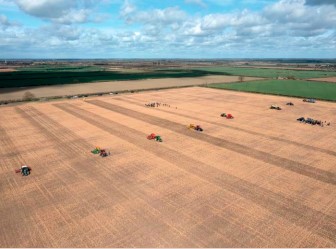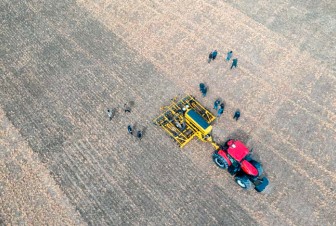Direct drilling into heavy clays is a battle still to be won

Eight years of trials with cover crops and direct drilling has prompted more questions than answers.
The soil advisers at Agrii like to remind me that there is more to direct drilling than simply placing the seed into uncultivated ground. “You have to earn the right,” they tell me in reference to the need to first get the soil in to a condition where it will perform as expected. In my experience, ‘earn’ is an understatement. When the day comes that I am truly happy with how my direct drilled crops look and with the financial returns they deliver, it will be because I have battled hard to create that situation. This is not to say that I cannot grow crops by the direct drilling method. I can. In some years the financial returns are even reasonable, but as yet no direct drilled crop on this farm has produced a net return better than that sown after the ground was first cultivated with the Simba Solo. This is the root of my frustration.
I started on this journey to identify a direct drilling approach that worked on my heavy clay soils eight years ago. I selected a 22-acre field close to the home farm at Leadenham because it was near enough that I could monitor it regularly and at my convenience. The soil type, structure, and everything else was typical of many of the fields on my 1600-acre farm half of which is 50%+ clay. I’ve used this field to investigate a range of establishment regimes, species of cover crop and following crop options. Some have worked better than others, but I’ve also had two complete crop failures. This is turning out to be an expensive exercise, but I’m also relieved not to have followed the crowd and gone ‘all in’.
In harvest 2021, the long-term cover crop/direct drilling field produced a net return that was £180/ha less than the field immediately next to it which serves as the yearly comparison and where the crop is produced following the farm standard regime. This poorer financial performance reflects the cost of an additional pass to sow the cover crop, the costs of the seed itself, one or two applications of slug pellets and the lower yield of the spring barley crop. It amuses me that DEFRA is offering to pay £40/ha to farmers to sow cover crops.
This is only a small contribution to the true cost these crops have within my business and I for one will not be signing-up for any of the cover crop options on offer as part of the sustainable farming incentive. Like many, my motivation for direct drilling is to cut costs and save money. If I need to invest in new machinery, extend the rotation or bring in cover crops, then so be it. So far, my experience is one of ‘two-steps forward, one-step back’. This is far from the resounding success that many preach.

Cover crops are a case in point. After several years of seemingly making good progress and a small but noticeable improvement in soil condition, disaster struck. Come the spring, the ground was rock hard, and the spring barley crop suffered at best 15% germination. It was abandoned. We soon learned that without a gentle cultivation in the autumn to create a fine tilth, there is little chance of successfully establishing a cereal crop come the spring. We’ve also tried lightly grazing the cover crop with sheep – two to three days at a low stocking density – only to find they tread the ground too much and you lose the friable tilth. This neatly sums up my experience: direct drilling into heavy soils carries a high risk. The friable tilth created in the autumn needs to be preserved until the spring.
Having tried drilling cover crops directly into stubble and broadcasting the seed with a pneumatic spreader before rolling in, on the advice of others, I moved to a wide-row system. We had modified an old Simba Solo for use as an oilseed rape drill and fitted it with low-disturbance tines designed by Philip Wright of Wright Resolutions. The seed is sown in 45 cm rows before a Simba Unipress fitted with spring tines is pulled behind. This approach seems to be working well, so far.
Maintaining output
In most years, the clay soils tend to produce the highestyielding crops, but also require more work and horsepower. This is my dilemma: I want to maintain the output of this land but reduce my reliance on big tractors and heavy equipment. I willingly concede my Simba Free-flow drill has its limitations. This is not to say that I haven’t used it successfully to sow direct-drilled crops. I have and most of the crops that followed have been good, but it is not suited to drilling directly into cover crops or into autumn stubble where there is a thick layer of trash. In contrast, it works better where the ground has been lightly cultivated with the Simba Solo or in overwintered stubbles when the straw is less fibrous and partly decomposed.
It’s not that I can’t direct drill on heavy soil. In spring I can, but I’m finding direct drilling in the autumn on my heavy soils to be a challenge. By adding another, more suitable drill, to my list of implements I fear I will incur higher establishment costs, which need accounting for, and lower output. This is not a proposition I find acceptable. It is my desire to find a drill that I can use in the autumn, perhaps after beans and oats, to direct drill a cereal crop in to standing stubble and a cover crop. Such machines already exist. Those from Weaving, Amazone, Horsch and Horizon are all capable of drilling directly into stubble as well if not better, than my Simba Free-flow.
I need a mounted drill, probably a 4- or 6-metre, that complements my setup and gives me another option. My issue is the cost. I’ve lost count of the times I’ve heard someone say they’ve spent £150,000 on a drill only to claim they’re saving money. In contrast, I paid £19,000 in 2016 for my 8-metre Simba Free-flow and I would argue that my crops are more profitable. I can cultivate many acres for £150,000 and not suffer any yield penalties! I plan to keep this drill going for as long as is practically achievable. If in time, carbon credits are as valuable as a tonne of wheat then I realise my system will need to be reviewed.

Good soil structure
All soils suffer from compaction and while I have seen instances that some soils will ‘self-structure’, it is my belief that some form of intervention such as that involving a tine or sub-soiler is required periodically. This is especially so on the heavier soils. On the light and medium land, we grow sugar beet while elsewhere we sow oilseed rape using the modified Simba Solo, so it could be argued that remedial action of the sort I consider necessary is performed on a periodical basis as part of the rotation. Some our land destined for spring crops is cultivated in the autumn using the Simba Solo. Once there is a good flush of weeds it is sprayed off ahead of the winter. While my system works, I realise that to successfully sow through a cover crop in the autumn and in high trash situations, I need another drill.
To find a drill that could work in my system, this spring I hosted a drill demo in association with Agrii. The day attracted about 280 visitors, so clearly there are others like me. The demo field will be taken through to yield to see if the different drills were affected more or less by the conditions than the Simba Free-flow. Behind the demonstration drills, we made a pass with a straw rake. This is a reasonably inexpensive attempt to improve seedto-soil contact, improve water penetration and promote the efficacy of residual herbicides. It is already clear that on seven out of the 10 drills in trial, this tactic has increased germination by up to 15%.
I am also mindful of the continuing loss of plant protection products seen as essential to the profitable production of crops. I’m not suggesting that direct drilling will reduce the need for fungicides. It may even increase the incidence of certain diseases such as net blotch given that infected stubble is the primary source of inoculum, but I believe that the need for certain herbicides can be reduced. We rely heavily on glyphosate and although I have got on top of a black-grass problem, we are now seeing worsening situation with Sterile brome. We cannot continue to rely so heavily on herbicides to keep on top of problem weeds. Moving the soil less frequently should run down the weed seed bank and gradually reduce the amount of herbicide needed. Our current strategy has enabled us to achieve 99% black-grass control for £90/ha mainly through a move to roguing which has led to a 30% reduction in herbicide use.
It irritates me that for some of my industry cohorts, ‘direct drilling’ has become a new religion. The vitriol and other comments I have seen directed at some who question the merits of this approach is shameful. It stifles open debate and is bordering on abuse.